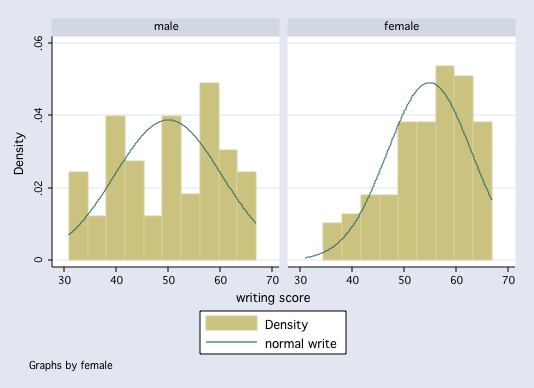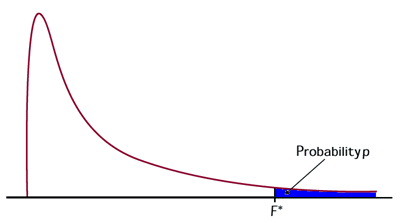The degrees of freedom, df = n - 1.
Use the table of the F Distribution with numerator and
denominator degrees of freedom.
Test Two Variances
It is possible to test any two variances from independent samples.
with degrees of freedom = n1 - 1 and n2 - 1.
Example
A math test is given in two classrooms. In the first classroom (21 students) the mean was 84.3
and the variance was 16.8. In the second classroom (16 students) the mean was 83.7 with a variance
of 42.6. Are the two classroom variances different?
The means of the two classrooms are very close but the variances seem different.
Compute the F-test: F = s2larger/s2smaller = 42.6/16.8
= 2.54.
Compute degrees of freedom: df = 15 and 20.
The critical value of F at alpha = 0.05 is 2.20.
Decision: Reject H0, the variances are significantly different.
Example Using Stata
display sqrt(16.8)
4.0987803
display sqrt(42.6)
6.5268675
sdtesti 21 84.3 4.1 16 83.7 6.53
Variance ratio test
------------------------------------------------------------------------------
| Obs Mean Std. Err. Std. Dev. [95% Conf. Interval]
---------+--------------------------------------------------------------------
x | 21 84.3 .8946933 4.1 82.4337 86.1663
y | 16 83.7 1.6325 6.53 80.22041 87.17959
---------+--------------------------------------------------------------------
combined | 37 84.04054 .8573489 5.21505 82.30176 85.77932
------------------------------------------------------------------------------
Ho: sd(x) = sd(y)
F(20,15) observed = F_obs = 0.394
F(20,15) lower tail = F_L = F_obs = 0.394
F(20,15) upper tail = F_U = 1/F_obs = 2.537
Ha: sd(x) < sd(y) Ha: sd(x) ~= sd(y) Ha: sd(x) > sd(y)
P < F_obs = 0.0267 P < F_L + P > F_U = 0.0622 P > F_obs = 0.9733
Stata Example
This example illustrates how the F-ratio for equal variances
can abe misleading.
use http://www.gseis.ucla.edu/courses/data/hsb2
sdtest write, by(female)
Variance ratio test
------------------------------------------------------------------------------
Group | Obs Mean Std. Err. Std. Dev. [95% Conf. Interval]
---------+--------------------------------------------------------------------
male | 91 50.12088 1.080274 10.30516 47.97473 52.26703
female | 109 54.99083 .7790686 8.133715 53.44658 56.53507
---------+--------------------------------------------------------------------
combined | 200 52.775 .6702372 9.478586 51.45332 54.09668
------------------------------------------------------------------------------
Ho: sd(male) = sd(female)
F(90,108) observed = F_obs = 1.605
F(90,108) lower tail = F_L = 1/F_obs = 0.623
F(90,108) upper tail = F_U = F_obs = 1.605
Ha: sd(1) < sd(2) Ha: sd(1) ~= sd(2) Ha: sd(1) > sd(2)
P < F_obs = 0.9906 P < F_L + P > F_U = 0.0199 P > F_obs = 0.0094
histogram write, by(female) normal bin(10)

F-max Test
The Fmax test is used to test homogeneity of variance in one-way analysis of variance
(ANOVA).
with degrees of freedom = k (number of groups) and n - 1 (number in each group).
You need to use the Table of the F-max Distribution.
Example
Thirty-two subjects are randomly assigned to one of four groups. One control group and three
groups with progressively increasing amount of reward. The means and variances of the three groups are:
G1 = 2.75 & 1.714, G2 = 3.5 & 0.857, G2 = 6.25 & 1.071, and G4 = 9 & 2.214.
Largest Variance = 2.214
Smallest Variance = 0.857
Compute the F-test: F = s2largest/s2smallest = 2.214/0.857
= 2.58.
Calculate degrees of freedom: number of groups = 4, number in each group = 8,
df = 4 & 7.
Critical value of F-max at alpha = 0.05 is 8.44.
Decision: Fail to reject H0, variances are not significantly different,
there is homogeneity of variance.
Test Pearson Correlation Using F
Here is a way to test whether a Pearson Correlation Coefficient is significantly different from
zero.
with degrees of freedom = 1 and n - 2.
Example
The correlation between physical punishment and aggression was .32 in a sample of 62 children.
Is this correlation significant?
First, compute r2: r2 = .322 = .1024
Compute F: F = r2/((1-r2)/(n-2)) = .1024/((1-.1024)/(62-2))
= 6.84.
Compute degrees of freedom: df = 1 and n - 2 = 60.
Critical value of F at alpha = 0.05 is 4.00.
Decision: Reject H0, correlation is statistically significant.
Intro Home Page
Phil Ender, 11Nov00




